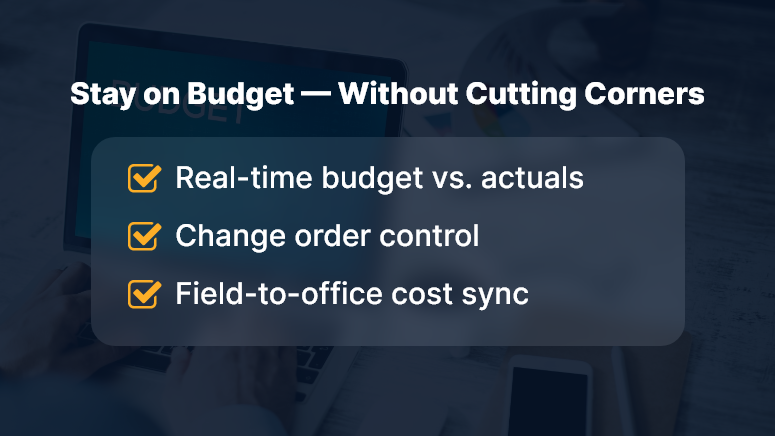Every construction project starts with a budget — but how often does it end there? According to McKinsey, large projects typically go 80% over budget and 20 months behind schedule. That’s not just frustrating. It’s financially devastating. But here’s the good news: keeping construction projects on budget is achievable — and you don’t have to cut corners or compromise on quality to do it.
In this blog, we’ll break down exactly how modern tools, smart planning, and digital project controls can help you stick to your numbers while delivering projects you’re proud of. If you’re a construction firm owner, project manager, or cost controller, this is for you.
Let’s turn cost chaos into cost control.
Why Staying on Budget Matters More Than Ever
Construction costs are skyrocketing. From labor shortages to material price volatility, the industry is under serious pressure.
So, why should you care about precise budget control?
- Protects profitability: Every dollar saved directly improves your project margins.
- Builds client trust: Consistently staying on budget makes you the partner clients want to work with.
- Improves predictability: Accurate cost tracking helps you forecast better for future projects.
Real-world pain points:
- Surprise expenses from the field: When site data isn’t updated in real time, field teams overspend without visibility.
- Manual cost tracking: Spreadsheets break easily and don’t scale with growing complexity.
- Delayed updates: If financial insights reach you too late, it’s impossible to take proactive action.
This is where platforms like OConstruction come in — putting budget visibility, real-time data, and automated cost tracking in one place.
Best Practices to Keep Construction Projects on Budget
1. Start with a Rock-Solid Cost Estimate
- Use historical data, supplier quotes, and realistic contingency buffers.
- Avoid underestimating site conditions, regulatory hurdles, or material costs.
2. Digitize Your Job Costing Process
- Move away from spreadsheets to real-time cost dashboards that integrate with project schedules.
- Use job cost codes to categorize expenses for better reporting and accountability.
3. Monitor Field Spending in Real Time
- Equip your team with mobile apps to log costs, purchases, and equipment usage on the go.
- OConstruction’s mobile interface makes this seamless.
4. Track Budget vs. Actuals — Daily
- Set up alerts and color-coded dashboards for cost overruns.
- Compare budgeted vs. actual labor hours, materials, subcontractor costs, and overhead in one place.
5. Manage Change Orders Like a Pro
- Treat change orders as mini-projects with their cost tracking.
- Log them immediately, assign budget impacts, and keep clients in the loop.
6. Use Integrated Procurement Workflows
- Reduce duplicate orders and vendor miscommunications.
- Link your cost tracking tools to your procurement and PO systems.
7. Assign Clear Financial Roles on Site
- Define who approves what, and when.
- Automate approvals and routing using a construction ERP like OConstruction.
8. Review Cost Reports Weekly (Not Monthly)
- Set up weekly “cost check” meetings with PMs, foremen, and finance leads.
- Use insights to make mid-course corrections.
Use Case Example: Saving $180K on a Mid-Sized Project
For example, BuildRight Contractors, a commercial firm, used OConstruction’s Budget Control and Field Logging modules to recover $180,000 in potential cost overruns. Here’s how…
- They digitized daily field reports using OConstruction’s mobile app
- Cost data synced instantly with project budgets
- Change orders were logged and approved on the same day
- Procurement was linked directly to the cost code system
As a result, their project wrapped 6 weeks early — with budget savings reinvested in the next job.
Key Takeaways: Keep Projects Profitable Without Sacrificing Quality
Staying on budget isn’t about spending less — it’s about spending smart.
By adopting digital cost tracking tools and linking your field, finance, and office teams, you gain:
- Real-time visibility into every dollar spent
- Fewer surprises from the field
- Faster response to cost overruns
- Stronger trust with clients and subcontractors
With a platform like OConstruction, budget control becomes part of your daily workflow — not a separate task at the end of the month.
Ready to take control of your construction budget — without cutting corners?




